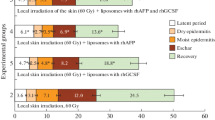Summary
Tumor-bearing and normal BALB/c mice were examined for their responsiveness to contact-sensitizing agent oxazolone after whole-body microwave hyperthermia treatment. The effective therapy with hyperthermia prolonging mean survival time of the animals and causing tumors regression resulted in strongly pronounced hyporeactivity to oxazolone. The impaired responsiveness remained unchanged until death of the tumor-bearing animals. In the case of tumor-free animals delayed cutaneous response returned to normal values within 8–12 days after hyperthermia treatment. It is documented that the longer exposure to hyperthermia sessions the more pronounced depression of reactivity to oxazolone occurs.
Similar content being viewed by others
References
Asherson GL, Ptak W (1968) Contact and delayed hypersensitivity mouse. I. Active sensitization and passive transfer. Immunology 15:405–414
Davies AJS, Carter RL, Leuchars E, Wallis V (1969) The morphology of immune reactions in normal thymectomized, and reconstituted mice. II. The response to oxazolone. Immunology 17:111–126
DeHoratius RJ, Hosea JM, Van Epps DE, Reed WP, Edwards WS, Williams RC (1977) Immunologic function in humans before and after hyperthermia and chemotherapy for disseminated malignancy. J Natl Cancer Inst 58:905–912
Dickson JA, Muckle DS (1972) Total body hyperthermia versus primary tumor hyperthermia in the treatment of rabbit VX2 carcinoma. Cancer Res 32:1916–1923
Gascoyne RD, Whitney RB, Levy JG (1978) Recovery of immune competence after tumor resection in mice: rorrelation with loss of suppressor elements. Br J Cancer 37:190–198
Harris JW, Meneses JJ (1978) Effects of hyperthermia on the production and activity of primary and secondary cytolytic T-lymphocytes in vitro. Cancer Res 38:1120–1126
Hellström KE, Hellström I, Nepom JT (1977) Specific blocking factors — are they important? Bioch Bioph Acta 473:121–148
Hill RP, Bush RS (1969) A lung colony assay to determine the radiosensitivity of the cells of a solid tumour. Int J Radiat Biol 15:435–444
Kovasc CJ, Hopkins HA, Evans MJ, Looney WB (1976) Changes in cellularity induced by radiation in a solid tumour. Int J Radiat Biol 30:101–113
Leith JT, Miller RC, Gerner EW, Boone MLM (1977) Hyperthermic potentiation. Biological aspects and applications in radiation therapy. Cancer 39:766–779
MacDonald HR (1977) Effect of hyperthermia on the functional activity of cytotoxic T-lymphocytes. J Natl Cancer Inst 59:1263–1268
Marmor JB, Hahn N, Hahn GM (1977) Tumor cure and cell survival after localized radiofrequency heating. Cancer Res 37:879–886
Mondovi B, Santoro AS, Strom R, Faiola R, Fanelli AR (1972) Increased immunogenicity of Ehrlich ascites cells after heat treatment. Cancer 30:885–888
Myking AO (1974) Histological changes in mouse lymph nodes and skin following repeated skin painting with oxazolone. Acta Pathol Microbiol Scand [A] 82:249–254
North RJ, Kirstein DP, Tuttle RL (1976) Subversion of host defence mechanisms by murine tumors: I. A circulating factor that suppress macrophage-mediated resistance to infection. J Exp Med 143:559–573
Pike MC, Snyderman R (1976) Depression of macrophage function by a factor produced by neoplasms: A mechanism for abrogation of immune surveillance. J Immunol 117:1243–1249
Rosen P (1976) Random repression, immunological surveillance, and hyperthermia. Cancer Letters 2:59–62
Streffer C (1978) Cancer therapy by hyperthermia and radiation. Proceedings of the 2nd International Symposium, Essen 1977. Urban & Schwarzenberg, Baltimore Munich
Yerushalmi A (1976) Influence of metastatic spread of whole-body or local tumor hyperthermia. Eur J Cancer 12:445–463
Author information
Authors and Affiliations
Rights and permissions
About this article
Cite this article
Roszkowski, W., Wrembel, J.M., Roszkowski, K. et al. Effect of whole-body microwave hyperthermia on delayed cutaneous hypersensitivity in tumor-bearing mice. J Cancer Res Clin Oncol 97, 23–29 (1980). https://doi.org/10.1007/BF00411275
Received:
Accepted:
Issue Date:
DOI: https://doi.org/10.1007/BF00411275




